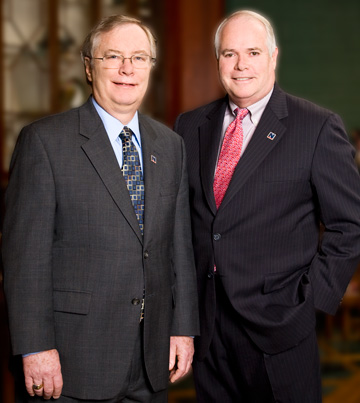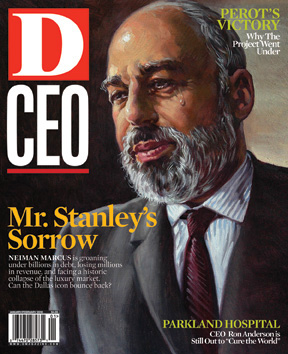
Mulkey, 60, was the chief executive of Stafford, Texas-based Wenaas USA, a manufacturer and distributor of industrial work wear for oilfield-service firms. When oil prices were $147 a barrel in mid-2008, his company notched record sales and profits. But when oil later dropped to $35 a barrel, he watched sales plummet. Rather than give Mulkey a chance to restructure operations, he says, the company’s Swedish owners simply slashed expenses—beginning with the CEO.
“My first thought was, ‘Wow. What now?’ ” Mulkey recalls. “I had to start the long process to find that next assignment. I wondered, ‘Am I going to get lucky? Or, with the economy the way that it is, is this going to be a two- to three-year process?’ ”
While he seeks out his next CEO post, Mulkey has started a consulting business specializing in global wholesale distribution and interim management.
Sagehorn, 52, took a different path to joblessness. After earning his MBA at the University of Nebraska, he went to work for AT&T, but soon discovered he had an entrepreneurial bent that wasn’t satisfied there—or at his next stop, Nokia. He kept his eyes open for the right opportunity, which finally appeared in the form of an offer from Natcom, which was looking for a CEO to manage manufacturing facilities in Fort Worth, Peru, and Chile.
Sagehorn accepted the challenge and built the U.S. enterprise to 500 employees and $50 million in annual revenue before Natcom—which became A Novo Americas—and its parent company ran out of expansion capital. He left to help a friend restructure his consulting firm, all the while biding his time as he pursued his entrepreneurial dreams: a start-up, web-based B2B consulting firm and the purchase of an existing business to turn around and run long-term.
Mulkey and Sagehorn share in common one thing—besides facing career upheaval in their 50s—that binds them and about 300 other CEOs and advisers together: active membership in a pioneering, career-support group for chief executives called CEO Netweavers.
Founded in Dallas in 2001 by John Casey III—a Harvard MBA and entrepreneur—CEO Netweavers started simply as a networking group for out-of-work local CEOs. The organization took its name, as well as its original mission, from Robert Littell, who coined the term “netweaving” in his book, The Heart and Art of NetWeaving. The concept in its most basic form is that traditional networking is about “What can you do for me?” while netweaving is more concerned with “What can I do for you?”
CEO Netweavers, according to Casey, is a group of “givers” rather than “takers.” And it’s true that whenever one meets with its members, the first question out of their mouths almost invariably is, “What can I do for you?” Strangely enough, they also seem to mean it.
The affable Casey, 61, himself comes off as unassumingly as a well-connected executive could. His father, John Casey Jr., once ran Braniff Airlines, and his uncle Al Casey was CEO of Fort Worth-based American Airlines, Times Mirror, and the Resolution Trust Corp.
Now working in executive search for Hudson, Casey says he saw the need for a CEO networking organization after noting that there were many such groups for executives in banking and finance, for example—but none for top-level execs in general.
His timing couldn’t have been better. With the shock waves that rippled through the economy following 9/11, 2001 proved a terrible time to get a job. Casey’s group began with 10 members, a figure that swelled to 60 within two months. The group continued to grow despite a key misjudgment.
“In those early days, we didn’t understand what we were doing,” Casey says. “When you got a [new] job, you were kicked out of the organization. This created a problem. Suddenly, we had a growing stigma as ‘unemployable’ CEOs. Having an image as unemployable is not a good thing.” Discovering Its Mission
To counter the problem, the group dropped its requirement that members who found new jobs be given the boot. Today the group’s credo is “Netweaver for life,” causing Casey to jokingly refer to the organization as the “YPO [Young Presidents’ Organization] for old folks.”
To further help with its image issues, CEO Netweavers hired Dallas’ Richards Group to conduct a branding exercise and help formulate a mission statement. The result—“Transforming business and enriching lives through servant leadership”—was a surprise even to Casey.
“I had never even heard of ‘servant leadership’ until we did that survey,” he says. “But as Netweavers, when we give, we’re serving. By definition we’re serving; we serve by connecting. We were there to share skills, experience, and relationships without expecting anything in return.”
A quick check of Google led Casey to the Indiana-based Greenleaf Center for Servant Leadership, where he discovered both the man who invented the concept (Robert K. Greenleaf, in his 1970 book The Servant as Leader), and the principles that had guided Casey’s own management style, albeit unconsciously, throughout his career.
Oddly enough, the theme of “discovering” servant leadership principles through CEO Netweavers was shared by just about every member I interviewed for this story. Mulkey, for example, says that “when I first ascended to the executive level, management theory seemed to be that you had to be a ‘Type A’ personality to get peak performance—a hard-charging, merciless, take-no-prisoners type like [Al] Chainsaw Dunlap or Jack Welch.
“But as I matured and took on more roles, I felt I wanted people to follow because they enjoyed working there and would do the extraordinary things it takes to be successful because they wanted to do them,” Mulkey says. “I saw Herb Kelleher at Southwest Airlines, and people enjoyed going to work. You could see it was a fun organization to work for, and it performed well. When I found CEO Netweavers talking about servant leadership, it was something that made perfect sense to me, even though it was the first time I’d heard of it.”
Frank Bracken, who retired as president of Dallas’ Haggar Clothing Co. in 2006 and joined CEO Netweavers shortly afterward, echoes Mulkey’s sentiment. “I truly was a servant leader before I heard the term,” Bracken says. “It was just part of my management style. One of the most important things in business is letting people know you really care about them.”
Essentially, servant leadership is focused on serving others by listening to their ideas and concerns, being committed to their personal development and well-being, building a strong sense of community and shared vision, and instilling confidence in the leadership and direction of the organization.
Today, CEO Netweavers revolves around the twin pillars of netweaving—or “networking for givers”—and promoting servant leadership. And it’s grown robustly, with so many meetings that even Casey can’t keep track of them.
Selective Membership
the group’s general meeting takes place Thursday mornings at the law offices of Jones Day on Harwood. It typically features a prominent speaker on the subject of servant leadership. In addition to that and the occasional social meeting, CEO Netweavers boasts a brace of so-called special interest groups that have cropped up around its members’ particular concerns. Besides general-interest committees such as Navigating for Business Success, the “caring” committee, and various community outreach groups, there are many dedicated to specific niches such as technology, health care, mergers and acquisitions, boards of directors, and sales professionals.
Membership in CEO Netweavers, which is a 501(c)(6) organization supported by members’ dues, also has become more selective over the years. The process requires a potential member to be recommended by a sponsor, who forwards a letter of recommendation along with a résumé or bio to the chairman of the membership committee. This person then forwards the information to four or five committee members who each conduct an interview with the prospective member, then gather with the full committee to report their findings and vote. It’s all meant to “separate the givers from the takers,” as Casey puts it.
“We still make mistakes,” he says. “We’re probably about 80/20 in identifying givers versus takers, but the takers eventually wander off.”
Casey recently stepped down as Netweavers’ CEO in favor of Phil Resch, a managing partner of the executive search firm The Sandhurst Group. “People leave because they don’t feel comfortable,” Resch says of the membership-winnowing process. “They’re not doing what the others are doing. You’re either genuine, or you’re not.”
Despite its conservative approach to adding members, the group is continuing to grow, with existing branches in Atlanta and Houston, a start-up planned for Austin, and possible expansions into Chicago and Charlotte. The Atlanta branch recently doubled to 100 members and, according to Resch, is about to double again in the next year.
Over the long haul, Casey has national ambitions for CEO Netweavers—and even bigger plans for servant leadership in general. He describes his vision as “12 to 26.”
“It’s estimated that 12-13 percent of CEOs in the U.S. could be classified as servant leaders,” he says. “Whether they call themselves that doesn’t matter. Do they behave that way? Another 12-14 percent could be, but aren’t. My vision is that CEO Netweavers will help drive that number from 12 to 26 percent before I die. I think that that number might be the ‘tipping point’ for servant leadership.”
Meantime, the unique group he founded is making its mark on the Dallas business scene. In Mulkey’s case, at least one out of every three diners who passed our table during our morning meeting at a popular Galleria-area bakery stopped to greet him, and the majority were Netweavers’ connections. Though he’s still working those connections while awaiting his next CEO assignment, Mulkey landed his previous post at Wenaas USA through fellow Netweaver Jeff Cordes (COO at Walls Industries) and, during his time at Wenaas, returned the favor by hiring several Netweavers, including his CFO, Claude Smith.
Similarly, Sagehorn’s recent career moves have been shaped by his connections to the group. Since our interview, he teamed with two other Netweavers, Steve Reiter and Steve Carpenter, to launch Savings Corp. of America, a web-based business that negotiates low-cost telecom, energy, and logistics contracts. As of this writing, he and his two Netweaver partners were also preparing to sign a letter of intent to purchase another company.
ELEVEN CHARACTERISTICS OF SERVANT LEADERSHIP
CallingDo people believe that you are willing to sacrifice self-interest for the good of the group?
Listening
Do people believe that you want to hear their ideas and will value them?
Empathy
Do people believe that you understand what is happening in their lives and how it affects them?
Healing
Do people come to you when the chips are down or when something traumatic has happened in their lives?
Awareness
Do others believe you have a strong awareness of what is going on?
Persuasion
Do others follow your requests because they want to or because they “have to”?
Conceptualization
Do others communicate their ideas and vision for the organization when you are around?
Foresight
Do others have confidence in your ability to anticipate the future and its consequences?
Stewardship
Do others believe you are preparing the organization to make a positive difference in the world?
Growth
Do people believe that you are committed to helping them develop and grow?
Building Community
Do people feel a strong sense of community in the organization that you lead?
Source: University of Nebraska white paper: “Becoming a Servant Leader: Do You Have What It Takes?”






